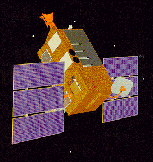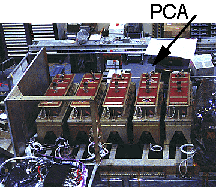


|
The Rossi X-ray Timing Explorer (RXTE) is used by astronomers to study
sources in the sky which emit X-rays. It does this through the use
of three different scientific instruments. One is a collection of
five proportional counters called the Proportional Counter Array
(PCA). Another is a set of scintillator detectors called the High Energy
X-ray Timing Experiment (HEXTE). The third instrument is the
All-Sky Monitor (ASM). These instruments will be described below.
|

|

|
The PCA has five Xenon gas proportional counters in which the X-rays
interact with the electrons in the Xenon gas. It views about 1 degree
of the sky at a time, but does not produce a "picture" of that region.
It instead measures the energy of the X-ray and the time it arrived at
RXTE. The PCA measures X-rays in the energy range 2-60 keV, and can
time the arrival of an X-ray to RXTE to within 1 microsecond.
Show me a movie about the PCA ! AVI Format (1233 kbytes) or Quicktime Format (1363 kbytes) |
HEXTE has eight sodium-iodide crystal detectors that are gathered into two
clusters, each containing 4 detectors. HEXTE looks at the same region
of the sky as the PCA. But while one cluster is pointed directly
at the X-ray source, the other cluster is slightly offset, looking at
a nearby region which doesn't contain any X-ray sources.
Each cluster is on a mechanical rocking mechanism, which "rocks" (by rotating
on its axis) once every 32 seconds. So a given cluster will be pointing at
the source for 32 seconds, then shift to an off-source position and stay
there for 32 seconds, then shift back to the on-source position. (the other
cluster is doing the opposite: off-source, on-source, off-source.) The data
from one particular cluster are analyzed by subtracting the off-source
position data from the on-source position data. This background subtraction
helps reduce the sources of "noise". HEXTE detects X-rays in the
energy range from 15 - 200 keV.
Show me a movie about the HEXTE !
AVI Format (1230 Kbytes)
or
Quicktime Format (1101 Kbytes).
Show me a movie about the ASM !
AVI Format (1505 Kbytes)
or
Quicktime Format (1373 Kbytes)
It is good that parts of the ranges of these three instruments overlap - it
increases confidence in one's scientific results! The ASM is a good
instrument for monitoring the sky for transient, or short-lived events. The
PCA and HEXTE complement the ASM by having the ability to follow up anything
the ASM sees with more detailed and sensitive observations. As
another example, while both the PCA and HEXTE observe the same region
of the sky, they are sensitive to a different range of X-ray energies.
However, the ranges overlap so that data from the two instruments can
be directly compared.
RXTE uses solar panels for power. The solar energy that they provide is the
same as the solar energy we talk about using to make solar cars and solar
houses on Earth. For communication with the the mission operations
center, RXTE uses two high gain antennas and several low gain ones.
Here's an animation showing the deployment of the solar panels and antennas:
AVI Format (2136 Kbytes)
or
Quicktime Format (1857 Kbytes)
RXTE uses star trackers for finding and staying pointed on the desired
X-ray source.
RXTE was launched on Dec 30, 1995.
Here's a movie of the launch:
AVI Format (2121 Kbytes)
or
Quicktime Format (1926 Kbytes)
Live from RXTE! is a project out of the
High Energy Astrophysics Science
Archive Research Center (HEASARC),
Dr. Nicholas
E. White (Director), within the
Laboratory for High Energy Astrophysics (LHEA) at
NASA/GSFC.
Website Text Authors: Live from RXTE!
Team
The ASM has three cameras that are mounted on a boom off the end of the
spacecraft. Inside each camera is a proportional counter sensitive to
X-rays in the 2-10 keV range. Each camera is able to look at a different
region of the sky, but two of the cameras have an overlapping field-of-view.
The entire boom the cameras are mounted on rotates by 6 degrees once every 90
seconds. Through this sequence of rotating and then staying fixed for 90
seconds, etc., the ASM examines 80% of the sky in 90 minutes.


Responsible NASA Official:
Questions/Comments/Feedback
Privacy, Security, Notices